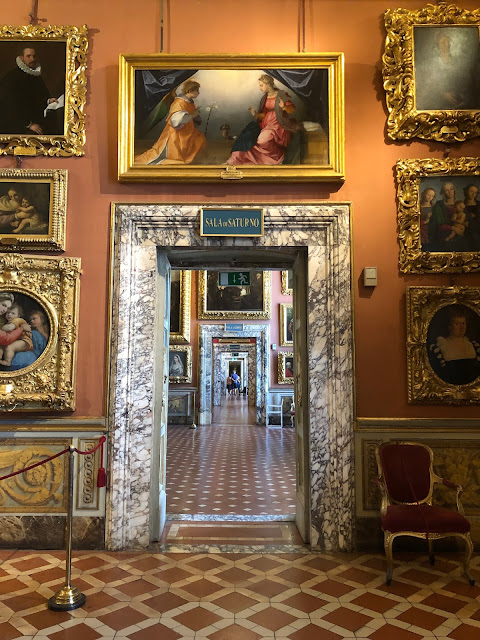【フィレンツェ】ピッティ宮殿とトスカーナ大公国 Firenze - Palazzo Pitti & Granducato di Toscana
ヴェッキオ橋を渡って、しばらく歩いていくと、左側に巨大な建物が現れる。それがピッティ宮殿だ。
この宮殿の背後には、広大なボーボリ庭園が広がっている。
フィレンツェの街は、初めはアルノ川の右側に作られ、そこから次第に広がっていったために、街の中は通りも狭く、教会などの建物や貴族たちの宮殿や住まいが密集して立っている。
一方、アルノ川の左岸は、後から開発されていったので、こうした巨大な宮殿を作ることができたのだろう。
After crossing the Ponte Vecchio and walking for a while, a huge building will appear on the left side. That is Pitti Palace.
Behind this palace is the vast Boboli Gardens.
The city of Florence was initially built on the right side of the river Arno and gradually expanded from there, so the streets are narrow and the buildings such as churches and the palaces and residences of the aristocrats stand densely. ..
On the other hand, the left bank of the Arno River was developed later, so it would have been possible to build such a huge palace.
この宮殿のある場所には、もともとフィレンツェの名家の一つだったピッティ家の私邸が建っていた。
それを、初代フィレンツェ大公コジモ1世の妃だったスペイン出身のエレオノーラ・ディ・トレドが1549年に買い取って、大規模な改築を始めた。
もともとの設計は、ブルネレスキがメディチ家の宮殿様に行なった設計を参考にしたと言われている。
このやや無骨な印象の正面のデザインは、ルネサンス建築を代表するデザインで、バイエルン王国のヴィッテルスバッハ家が統治するミュンヘンのレジデンツは、このデザインを取り入れている。
In the place where this palace is located, the private residence of the Pitti family, which was originally one of the famous houses in Florence, was built.
Eleanor of Toledo from Spain, the princess of the first Grand Duke of Florence, Cosimo I, bought it in 1549 and began a major renovation.
The original design is said to have been based on Brunelleschi's design for the Medici palace.
This slightly rugged front design is representative of Renaissance architecture, and the Residents of Munich, governed by the Wittelsbach family of the Kingdom of Bavaria, have adopted this design.
入口を入ると、巨大な中庭が現れる。このピッティ宮殿は3階建てで、内部にはパラティーナ美術館、近代美術館、陶磁器博物館などの様々な施設がある。
エレオノーラの父は、ナポリ王国の副王も勤めたほどの人物で、エレオノーラはこの場所を自らの持参金で購入したという。
それまでメディチ家は、フィレンツェの中心のヴェッキオ宮殿で暮らしていたが、宮殿は街中にあり、周囲に大きな庭もなかったので、エレオノーラは伸び伸びと暮らすことのできるこの場所で暮らすことを望んだようだ。
When you enter the entrance, a huge courtyard appears. The Pitti Palace is a three-story building with various facilities such as the Palatine Gallery, the Museum of Modern Art, and the Ceramic Museum.
Eleonora's father was also the deputy king of the Kingdom of Naples, and Eleonora said he bought the place with his own dowry.
Until then, the Medici lived in the Palazzo Vecchio in the center of Florence, but since the palace was in the city and there was no large garden around it, Eleonora seemed to want to live in this place where he could live comfortably. That's right.
ピッティ宮殿の背後には、広大なボーボリ公園が広がっている。
イタリアで最も美しい庭園とされて、その後のヨーロッパの宮殿のモデルにもなった。
Behind the Pitti Palace is the vast Boboli Gardens.
It was considered the most beautiful garden in Italy and later became a model for European palaces.
この宮殿とボーボリ庭園を一通り回るだけでも、ゆうに半日以上は必要になりそうだ。
今回の旅では、パラティーナ美術館だけを訪れることにした。
パラティーナ美術館は、ピッティ宮殿の2階にある。中に入ると、豪華絢爛な部屋がずっと向こうまで続いている。
It will take more than half a day just to go around this palace and the Boboli Gardens.
For this trip, I decided to visit only the Palatine Gallery.
The Palatine Gallery is located on the second floor of the Pitti Palace. Once inside, a gorgeous room continues all the way to the other side.
コジモ1世の子である、フランチェスコ1世、フェルディナンド1世の代になっても建築が続けられて、16世紀の終わりごろに、メディチ家の住まいは、ヴェッキオ宮殿からこのピッティ宮殿に正式に移された。
本来であれば、メディチ宮殿と読んでもいいように思えるが、元の所有者の名前が現在に至るまで使われている。
メディチ家の基礎を築いたコジモ・デ・メディチは、メディチ家への反発が大きくなりことを嫌って、とにかく目立たないように行動していた。
トスカーナ大公となったメディチ家にとってはすでにそんな心配をする必要は無くなったはずだが、そのコジモの精神をかろうじて引き継いでいたのだろうか。
Construction continued in the days of Francesco I and Ferdinando I, the sons of Cosimo I, and at the end of the 16th century, the Medici dwelling officially moved from Palazzo Vecchio to this Pitti Palace. Was done.
Originally, it may be read as Medici Palace, but the name of the original owner is still used today.
Cosimo de'Medici, who laid the foundation for the Medici family, hated the growing backlash against the Medici family and acted inconspicuously.
The Medici family, who became Grand Duchy of Tuscany, should no longer have to worry about it, but did he barely take over the spirit of Kozimo?
メディチ家は、18世紀後半になってその系統が断絶してしまい、トスカーナ大公の地位はそれ以降はハプスブルグ系のロートリンゲン家に引き継がれた。
ロートリンゲン家も、美術品の収集やこの宮殿の改築を続けたが、1854年にはこの宮殿を外部にも公開するようになった。
そしてついに1860年。イタリア統一の流れの中で、トスカーナ大公国はサルディーナ王国に併合され、コジモ1世以来、およそ300年続いたトスカーナ大公国の歴史は終わりを告げた。
この壮大なピッティ宮殿は、栄光に包まれたトスカーナ大公国の歴史を、現代の私たちに伝え続けている。
The Medici family was cut off in the latter half of the 18th century, and the status of Grand Duchy of Tuscany was taken over by the Habsburg Rothlingen family.
The House of Lorraine also continued to collect works of art and renovate the palace, but in 1854 the palace was opened to the public.
And finally 1860. In the process of unification of Italy, the Grand Duchy of Tuscany was merged into the Kingdom of Sardina, ending the history of the Grand Duchy of Tuscany, which has continued for about 300 years since Cosimo I.
This magnificent Pitti Palace continues to convey to us today the history of the Grand Duchy of Tuscany.
(Translated by Google Translate)









コメント
コメントを投稿